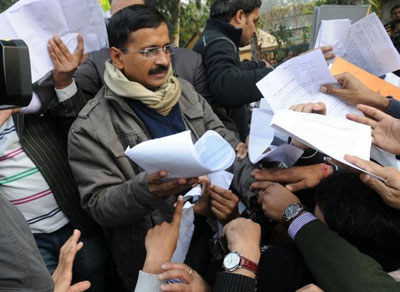 Does
Does Delhi chief minister Arvind Kejriwal consider himself an avatar of Mughal emperor Jahangir? Though he doesn’t reside in the Agra Fort or likes to be called Jahanpanah, his antic of holding a darbar- e-aam seems inspired by the Mughal Sultanate.
Jahangir, if you’ve read history or Amar Chitra Katha, was famous for his system of personal hearing and his ‘golden chain of justice.’ During his reign, anybody could stand outside his fort in Agra and request a personal audience with the emperor. For this, the supplicant had to just pull any of the 60 bells outside the castle.
Installing the bell of justice, or insaaf ka ghanta as it was called then, was among Jahangir’s first orders after he ascended the throne in 1605. This was done to ensure if those engaged in the administration of justice failed in their duty, the aggrieved could draw the emperor’s attention without fear.
Arvind Kejriwal’s attempt to hold a darbar on the roads of Delhi could have easily passed off as a spectacle from the Mughal era except that the chaos, screaming, shouting and mismanagement would have made even Jahangir hang his head in shame. But Kejriwal should stop the spectacle.
This isn’t medieval India. India is no longer run by Badshahs or Shenshahs. Atavistic ideas from history have no place in a modern democracy like ours.
Why does a chief minister of a city-state like Delhi need to sit in the middle of the road to hear the public? Is the CM a lowly babu who has to deal with applications? Or does he consider himself the final court of appeal capable of dispensing justice at the pull of a bell? If the answer to any of these is yes, we need a re-poll in Delhi.
Jahangir’s day and age were different. In a thriving democracy, with a huge, well-paid, well-fed executive, if an aam aadmi has to travel right up to the chief minister, it indicts the entire system for failure. It shows that every tier of executive—the babus, the bade babus and their officers—has become dysfunctional. Is that the case in Delhi?
There may be merits in the argument that people face problems in getting their work done; they come across obstacles when they want to be heard. But to believe that the entire system has failed and everybody needs to shake emperor Kejriwal’s bell of justice would be ridiculous. Frankly, what is it that Kejriwal is trying to achieve except some publicity and TV time?
It would be insane to believe that he would be able to solve every petitioner’s problem just by personally hearing him. The sheer magnitude of complaints he is required to redress would make it impossible for Kejriwal to focus on even a small percentage of them. Soon the backlog would start mounting and people would start calling him inefficient and incompetent.
That Kejriwal’s public hearings would not yield results isn’t a personal opinion. It is supported by evidence from similar experiments by several other politicians and chief ministers.
Take, Rajasthan for example. Janata darbars were a salient feature of Ashok Gehlot’s administrative style. Every day he used to meet hundreds of people who would queue up at his residence for a minute of the CM’s time. In the end, all Gehlot could do was to accept their applications and pass it on to the babus who accompanied him.
In short, a petitioner would travel all the way from his home, often in remote villages, only to find his problem being passed on to a clerk. Though Gehlot continued to hold his darbars—even Vasundhara Raje has retained the system—but it seldom helped in solving grievances.
The same people would keep returning to the darbar complaining that nothing had happened in spite of the CM’s personal interest in their problem. Instead of forcing people to jostle with each other for a minute with him, Kejriwal should ideally work on strengthening the existing system. The focus should be on ensuring that problems are solved at the lowest level of the administrative hierarchy.
Instead of making people come to his door, Kejriwal should create a system where the administration goes to the aam aadmi to solve his problem. Kejriwal needs to repair the existing pyramid, instead of turning it upside down. Even if he is keen on interacting with his janata, Kejriwal should use technology—heard of emails, text messages, helplines?—instead of sticking to ideas that looked innovative 500 years ago.
Jahanpanah, are you listening? #Source: FP, By Sandipan Sharma
 Does Delhi chief minister Arvind Kejriwal consider himself an avatar of Mughal emperor Jahangir? Though he doesn’t reside in the Agra Fort or likes to be called Jahanpanah, his antic of holding a darbar- e-aam seems inspired by the Mughal Sultanate.
Does Delhi chief minister Arvind Kejriwal consider himself an avatar of Mughal emperor Jahangir? Though he doesn’t reside in the Agra Fort or likes to be called Jahanpanah, his antic of holding a darbar- e-aam seems inspired by the Mughal Sultanate. 